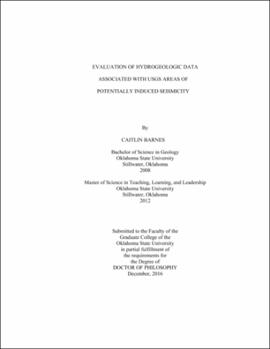| dc.contributor.advisor | Halihan, Todd | |
| dc.contributor.author | Barnes, Caitlin | |
| dc.date.accessioned | 2023-03-13T21:02:54Z | |
| dc.date.available | 2023-03-13T21:02:54Z | |
| dc.date.issued | 2016-12 | |
| dc.identifier.uri | https://hdl.handle.net/11244/337088 | |
| dc.description.abstract | The Central and Eastern United States have experienced an increase in seismic activity within the last forty years with a corresponding concern from the public regarding the associated seismic hazard. In 2015, the United States Geological Survey identified 17 areas at risk for seismicity induced through industrial processes. Each area contains research investigating the origin of seismicity and found possible correlations to injection disposal wells. These wells are often used by the petroleum industry to dispose of wastewater and other byproducts from the resource extraction process. As this fluid is pumped beneath the surface it increases pressures near critically stressed faults, which can induce seismicity. This study is a systematic review of the 17 identified potentially induced seismic areas to identify patterns among the varied geographical settings. With a focus on hydrogeology, the goals of this research include discovering what hydrogeologic data are available, how far pressure migration is expected to travel, and if a relationship exists to evaluate hydrogeologic risk of seismicity using available hydrogeologic data. Results of this study show a considerable lack of hydrogeologic data related to injection disposal wells and the injection interval. This research confirmed a proximal radius of 2.0 km (1.5 miles) where initial felt seismicity occurs. Fifty percent of seismicity occurs within 10 km (6.0 miles) of injection disposal wells, and 90% of the seismic activity occurred within 48 km (30 miles) of wells within the 17 PISAs. Based on this research, using estimated or textbook values for pressure migration prediction is not advisable due to the varied nature of geological settings. The collection of transmissivity, storativity, and formation pressure values, both at the well site and throughout the injection formation, would be worthwhile to adequately assess seismic hazards. This systematic review of the 17 areas provides a quantitative understanding of felt seismicity patterns for improving injection management practices and assessing seismic hazards. | |
| dc.format | application/pdf | |
| dc.language | en_US | |
| dc.rights | Copyright is held by the author who has granted the Oklahoma State University Library the non-exclusive right to share this material in its institutional repository. Contact Digital Library Services at lib-dls@okstate.edu or 405-744-9161 for the permission policy on the use, reproduction or distribution of this material. | |
| dc.title | Evaluation of hydrogeologic data in USGS areas of potentially induced seismicity | |
| dc.contributor.committeeMember | Marks, Steve | |
| dc.contributor.committeeMember | Donoghue, Joseph | |
| dc.contributor.committeeMember | Allen, Kevin | |
| dc.contributor.committeeMember | Angle, Julie | |
| osu.filename | Barnes_okstate_0664D_14919.pdf | |
| osu.accesstype | Open Access | |
| dc.type.genre | Dissertation | |
| dc.type.material | Text | |
| dc.subject.keywords | hydrogeology | |
| dc.subject.keywords | induced seismicity | |
| dc.subject.keywords | pressure migration | |
| dc.subject.keywords | subsurface fluid injection | |
| thesis.degree.discipline | Environmental Science | |
| thesis.degree.grantor | Oklahoma State University | |
